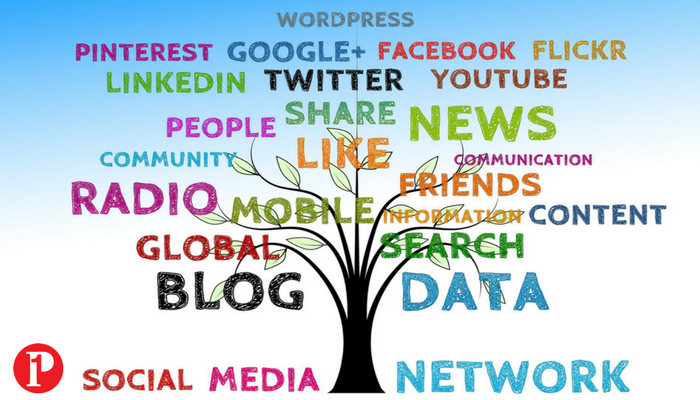
Are you posting the same type of content you did one year ago?
Three years ago?
If you’re sticking with your content marketing approach from three years ago, it’s now 50% less effective.
Content engagement, such as shares, likes, and comments on social networks, has halved since 2015.
Here’s what’s happened, and we’ll discuss what strategies and tactics you can do about it.
CONTENT SATURATION IS MAKING IT HARD TO STAND OUT
As topics become popular, there is often an explosion in published content which saturates the topic area. An extreme example is Bitcoin which became a very popular topic at the end of 2017. The growing interest was accompanied by a significant rise in articles about the cryptocurrency as shown below.
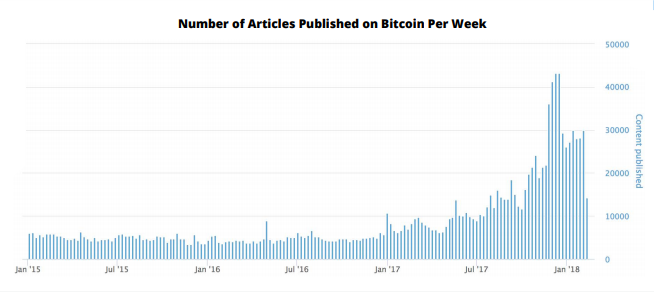
By December 2017 there were over 40,000 articles a week being published about Bitcoin.
Bitcoin is exceptional, however many find the same pattern again and again.
Popular and trending topics tend to get saturated with content very quickly.
WHEN IT COMES TO CONTENT, AGE MATTERS. A LOT
Different content preferences clearly reveal themselves when we cut our data by age (see chart below). Millennial respondents show the strongest preference for video and social content. In contrast, Gen X and Boomers prefer more news articles, research reports, and email content, meaning most traditional content teams still have interested readers.
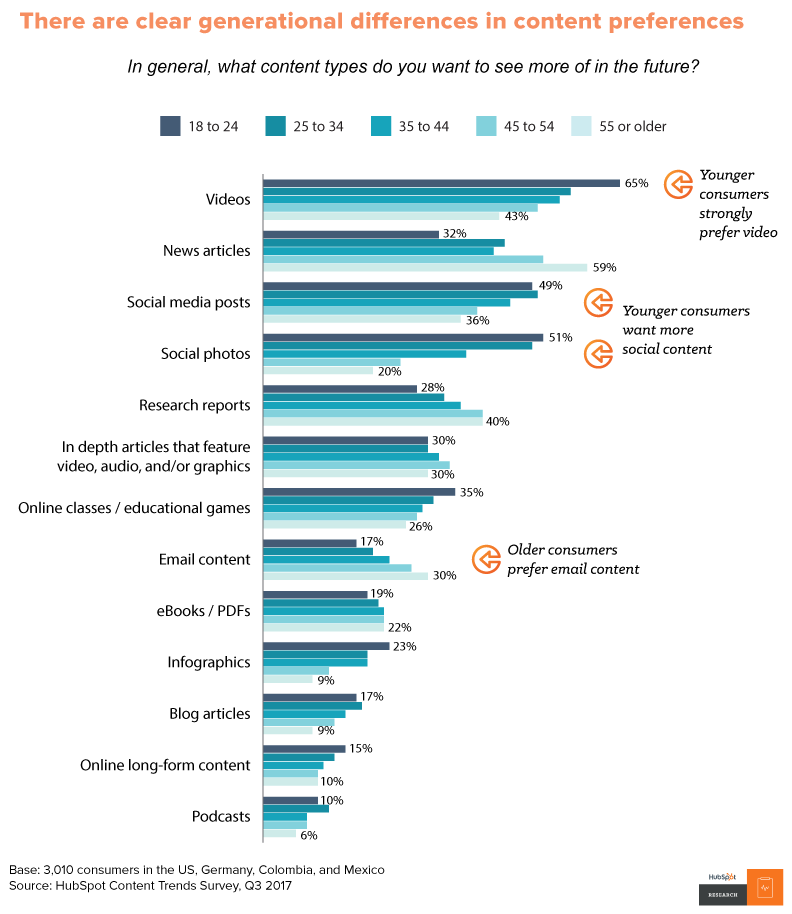
THE INCREASE IN CONTENT PUBLICATION MEANS GREATER COMPETITION FOR ENGAGEMENT
According to the BuzzSumo report, In many topic areas they see that as the volume of content rises, the average number of shares per article declines. Below is a typical example, in this case tracking the number of articles published on machine learning and average Twitter shares.
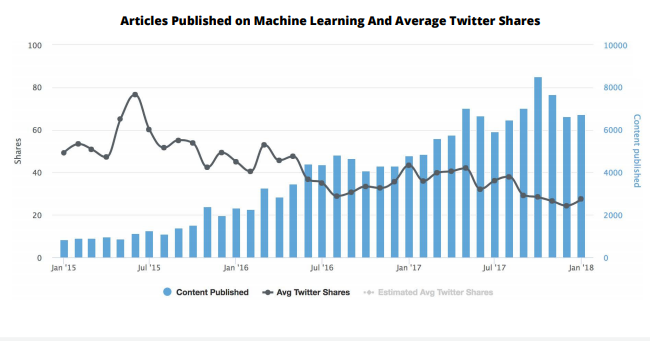
FACEBOOK CHANGES MAKE IT HARDER TO SEE AND SHARE PUBLISHER CONTENT
Most social engagement takes place on Facebook due to the sheer scale of the network. Their recent
algorithm changes have reduced the organic reach and distribution of brand and publisher content on the platform.
Facebook have also taken a clear view on promoting and demoting specific content types, such as clickbait headlines, in the news feed.
FACEBOOK CHANGED ITS ALGORITHM:
In the summer of 2017 Facebook announced changes to reduce the amount of clickbait content in the news feed. Facebook specifically said that posts with clickbait headlines, such as headlines that withhold information or exaggerate with sensational language, would appear lower in the News Feed.
People may simply be fed up with clickbait headlines, but it also seems very likely that the algorithm changes made by Facebook have significantly reduced the distribution and visibility of these types of posts.
My experience it has been more of the latter and that’s the feedback I’m getting from businesses.
FALLING ENGAGEMENT WITH FACEBOOK POSTS
We are seeing a consistent fall in Facebook engagement for publishers. Last year we reported on a 20% fall in Facebook engagement for major brands and publishers.
This appears to have continued over the last six months. Parse.ly’s referrer dashboard shows a steady decline in referral traffic to publishers from Facebook.
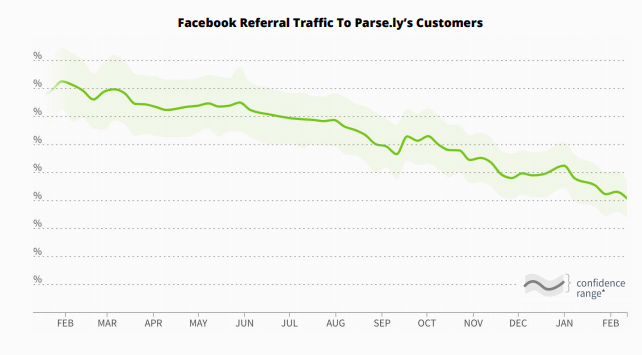
On 11th January 2018, Mark Zuckerberg announced that Facebook would be updating its news feed algorithm to prioritize content from “friends, family and groups.” These latest changes may further reduce the visibility of publisher content in the news feed, and we may well see further falls in Facebook engagement.
CONTENT DISCOVERY IS CHANGING
Research from Hubspot reveals that people find content through a multiplicity of channels beyond Google and Facebook. What is interesting is the growth in people finding content through mobile notifications and Slack channels.
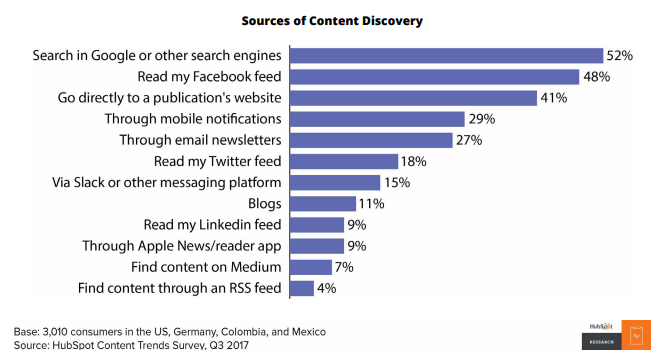
The good news for marketers is that owned websites and email newsletters also rate quite highly, which reinforces the case for publishing content on your own site and building your own email list. SEO still matters.
A FLIGHT TO QUALITY?
When you look at sites like the Harvard Business Review or The Economist we find content sharing has bucked the general trend and increased.
Seven of the top ten most shared articles on Harvard Business Review over the last five years were published in 2017. The other three were published in 2016. The median number of shares was lower in 2017 than in the previous two years, but the average number of shares increased from 4,007 in 2015/16 to 4,506 in 2017.
The two most shared posts from The Economist over the last 5 years were both published in 2017. The median number of shares for posts published by The Economist in 2015 and 2016 was 43. In 2017 it increased to 78. The average number of shares in 2017 was slightly lower at 1,583 compared to 1,795 in the previous two years. The average number of linking domains was also higher in 2017 than the previous two years.
It appears that increased content competition has not adversely affected these sites. Paradoxically it may have helped them reinforce their position in a world of content saturation. If you are going to share something with your audience you want to make sure it is well researched and authoritative from a trusted source, thus it is possible people are more selective in their sharing.
GROWTH IN LINKEDIN SHARING
LinkedIn recently told Digiday that comments, likes and shares on the platform are up more than 60 percent year-on-year, due to product updates, new features and analytics.
The data also shows that while social engagement with content is falling on Facebook and Twitter, many B2B publishers are seeing increases in social sharing on LinkedIn. For example, here is a chart showing total shares of Forbes.com content on LinkedIn.
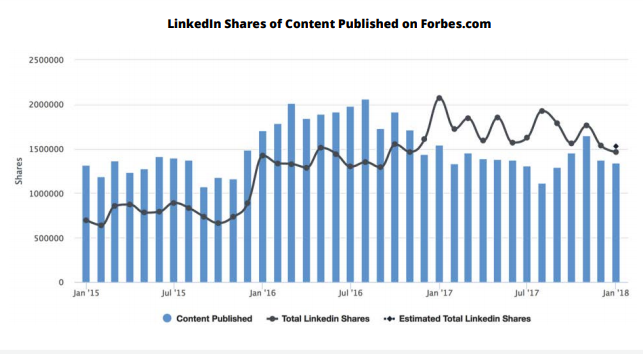
BE CLEAR ON YOUR GOALS OBJECTIVES FOR CONTENT AND SOCIAL MEDIA
Social remains important but potentially more for engagement and brand building rather than driving referral traffic. In terms of content, we must remember that social shares and links are just two metrics.
There are other important metrics such as traffic and conversions. The right metrics will depend upon your content objectives.
Your website is your hub!
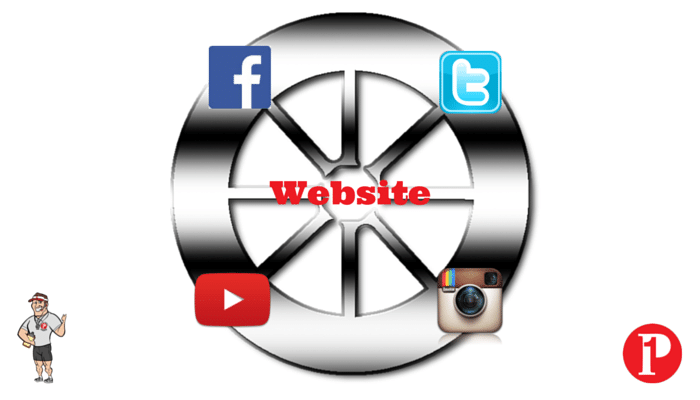
DON’T CHASE SHARES WITH VIRAL CONTENT AND HEADLINES
There is a danger that when marketers see their social shares fall, they may look to produce more viral content and headlines to gain shares. There are a number of problems with this approach.
- Broadening the content to get shares may lose the focus on the core commercial audience.
- There is evidence that audiences get tired of very similar viral content headlines and formats.
- Given Facebook are actively punishing headlines that withhold information or use exaggerated terms, there is a need to be careful when trying to create viral content.
FOCUS ON HIGH QUALITY CONTENT
In a world full of content, people want to share authoritative and quality content. This also applies to links. People want to link to the best content they can find. Thus if you want to gain links, you really need to produce one of the very best articles on the topic. That means deep research, long form content, original findings.
This takes more time, but the evidence suggests that you are better off investing time in the creation and promotion of fewer high quality articles than a large volume of lower quality ones.
About Blair

Blair Evan Ball is a Social Media Coach and founder of Prepare1, a company that works with businesses, individuals and non-profits. He is a former executive with a Fortune 50 company, and his national division did $1Billion+ in sales annually.
Blair has written three e-books: Facebook for Business Made Easy, Facebook Pages for Business Made Easy, and WordPress Blog Setup Made Easy.
Blair also educates, trains entrepreneurs and business professionals how to amplify their brand, increase revenues, and raise more funds.
![[Study] How Will Businesses Change Their Social Media Activities 5 Golden Rules for Sharing on Social Media](https://www.prepare1.com/wp-content/uploads/2014/03/COACH-logohat-162x300.jpg) The Race is ON! | PREPARE | Get into the Game and WIN!
The Race is ON! | PREPARE | Get into the Game and WIN!
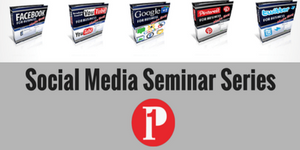



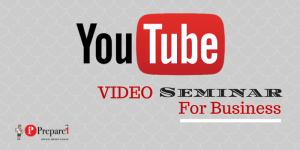





Comments on this entry are closed.